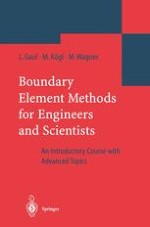2003 | OriginalPaper | Buchkapitel
Dual Reciprocity Method for Potential Problems and Elastodynamics
verfasst von : Prof. Dr.-Ing. habil. Lothar Gaul, Dr.-Ing. Martin Kögl, Dr.-Ing. Marcus Wagner
Erschienen in: Boundary Element Methods for Engineers and Scientists
Verlag: Springer Berlin Heidelberg
Enthalten in: Professional Book Archive
Aktivieren Sie unsere intelligente Suche, um passende Fachinhalte oder Patente zu finden.
Wählen Sie Textabschnitte aus um mit Künstlicher Intelligenz passenden Patente zu finden. powered by
Markieren Sie Textabschnitte, um KI-gestützt weitere passende Inhalte zu finden. powered by
One of the cornerstones of the Boundary Element Method is its use of fundamental solutions to eliminate the domain integral over the adjoint operator. In the absence of source terms, the resulting formulation contains only boundary variables, so that only the boundary of the body has to be discre-tised and not its domain. This reduces the number of nodal unknowns and greatly simplifies the meshing and remeshing process as compared to domain discretisation methods such as Finite Elements or Finite Differences.
